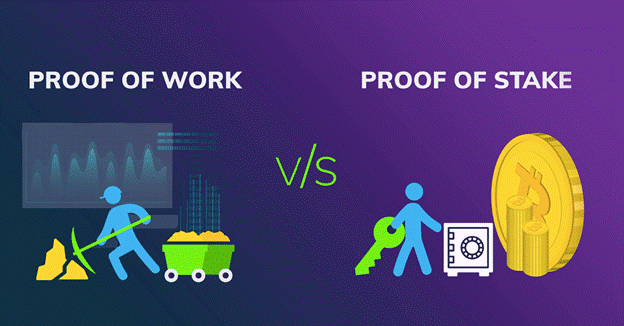STEEMIT CRYPTO ACADEMY SEASON 4-HOMEWORK POST FOR TASK 6//DIFFERENT TYPES OF CONSENSUS MECHANISMS by @moureenbronia
Welcome to my task 6 homework post. For this task, I will be answering the question;
WHAT IS THE DIFFERENCE BETWEEN PoW AND PoS? ADVANTAGES AND DISADVANTAGES? WHICH ONE IS BETTER IN SCALABILITY? EXAMPLES?
Consensus mechanisms. What are they? All blockchains whether public or private use consensus mechanisms. These are methodologies that are used to arrive to a necessary agreement about a single data across a decentralized computer network.
There are many types of consensus mechanisms that blockchains use for instance; proof of work(PoW), proof of stake(PoS), delegated proof of stake(DPoS), proof of capacity (PoC), proof of burn(PoB), proof of activity (PoA) and proof of elapsed time(PoET).

Image source
Among all these, PoW and PoS are the most commonly used consensus algorithms.
PROOF OF WORK
PoW is the original consensus algorithm in blockchain technology which was first conceptualized in 1993 by Cythia Dwork and Moni Naor. However, the name itself was given, defined and formalized by Markos Jakobsson and Ari Juels in 1999. PoW is used by cryptocurrencies like Bitcoin, Litecoin and Ethereum.
Image source
PoW is a consensus mechanism that involves solving complicated mathematical problems in order for miners to create new blocks. It requires the participants to prove that the work submitted by them qualifies them to receive the right to add new transactions to the blockchain.
ADVANTAGES
• It provides incentive to participants.
The first participant to solve the complicated mathematical problem is given the permission to add a new transaction to the block. This pushes participants to be active on the network.
• It is secure
As you know, PoW depends on the computational capabilities of the participants. These capabilities require one to invest in hardware which can be expensive considering the computing power this algorithm consumes. This however, makes the network safe from the 51% attack. This is possible because to get over 51% computing power, one would have to spend alot of money in buying computers and paying for electricity bills. In so doing, the costs out weigh the gains.
The 51% attack is a situation where someone gets more than half of the computing power (in regards to PoW) or half the cryptocurrencies in the network ( in regards to PoS). This would give this person the power to control and manipulate the network by validating wrong transactions and adding invalid blocks to the network.
• Authenticity and traceability.
Each transaction in the network has to be validated before it can be added to a block. This is done through solving complicated mathematical problems. It becomes impossible for participants to manipulate the system due to the complexity nature of the problems they have to solve. Once they manage to solve these problems, it proves that their work is authentic and can be traced.
DISADVANTAGES
Remember that PoW is based on computing power which means that participants have to invest in computer hardware. This means that they have to buy computers, constantly update their software and invest in an effective heat management system (for preventing overheating of computers which can result in damages). All of this cannot happen without money. Once they are in possession of these computers, they need electricity to fuel them. Put all the above factors together and it will simply show a constant increase in the expenses that participants incur.
• Unsustainability
PoW puts alot of strain on the environment. This is because of the tons of energy that it consumes. For example, in 2015, it was estimated that 1 BTC transaction required electricity that could be used to power 1.57 American households per day. Obviously, this number has gone up over the years. The end result is that miners keep on generating tons of electricity waste that could be put to other uses.
• Long processing time
It takes a long time for the PoW algorithm to process a transaction. This is because of the complexity of the mining process (solving complicated mathematical problems).
• Low transaction through put.
This is as a result of the long processing time. Alot if time is spent on the validation of one transaction hence leading to a low number of transactions validated per second compared to PoS.
• Increased centralization
There is an increase in the centralization of mining by large organized mining rigs. This is because, individuals donot have the capability to constantly upgrade their computer software and foot electricity bills. This give an opportunity to more organized and large mining rigs to dominate the mining process. This is a problem because it goes against the core blockchain principle which is decentralization.
• It negatively affect prices of cryptocurrencies.
Miners have to sell their coins for fiat money in order for them to be able to foot electricity bills and upgrade thier softwares. This leads to a downward movement in the prices of cryptocurrencies.
PROOF OF STAKE
It came into place to cater for the limitations of PoW. With PoS, miners are required to stake their own coins in order for them to participate in the mining process. The higher the stake, the higher the chances of a participant receiving the responsibility of maintaining the public ledger.
Image source
Cryptocurrencies like peer coin, NXT, EOS, black coin and shadow coin use this algorithm. Ethereum also plans to change to PoS as part of its development plan for Ethereum 2.0.
ADVANTAGES
Unlike PoW that consumes alot of energy, PoS consumes less energy. This is because; with PoS, the participant's mining power is limited to their percentage ownership staked instead of computing power.
• Helps the price dynamics of cryptocurrencies. This is because, a percentage of the tokens are always locked up. This reduces the amount of coins in circulation, thereby increasing their value.
• Less costly
PoS is not as expensive as PoW because, with PoS, the cryptocurrencies are already created therefore, participants don't need to mine. The cost effectiveness of PoS also comes from the fact that it is not based on computing power. That being said, participants do not need to invest in extensive computer hardware and software.
• Secure against the 51% attack.
The PoS algorithm is structured in a way that makes the attack disadvantageous to the attacker. How? Well, for one to carry out the attack, they would have to own more than half of the cryptocurrencies on the network. This is practically impossible because, once someone tries to buy such a huge amount of coins, the prices will shoot up. Not to mention, these coins would need to be staked first. But to go ahead with the attack would be a disservice to the attacker since they would lose all their staked coins in the process.
Therefore, the cost out weighs the gain.
• It is consistent.
Validators of transactions are chosen at random and constantly interchanged so there is no centralization of power.
DISADVANTAGES
• It is less secure compared to PoW.
When you compare the security of PoW and PoS algorithms, PoW will stand out. This is because, the security of PoW has been tested by some of the biggest cryptocurrencies like BTC and ETH which is not the case with PoS.
• It encourages cryptocoin hoarding.
As we already know, participants are required to stake their coins in the network and whoever has the most coins is given the responsibility of validating transactions. This encourages participants to hoard their coins in order for them to accumulate. In so doing, they sideline crypto trading.
WHICH ONE IS BETTER IN SCALING CAPACITY?

Image source
Scalability is the ability of a network to sustain a higher number of occurrences. Therefore, a scalability problem is when a network has limited capacity to handle a large number of transactions in a short span of time.
In terms of scaling capacity, PoS is better. This is why;
° In PoS, the entire network doesn't get involved in the transaction validation process. This is left to a technology called shrading.In blockchain, shrading means storing horizontal portions of the network in separate groups of nodes.
So instead of using the entire network to compete in who gets to validate a transaction like it's done in PoW, PoS uses shrading where separate stakers are needed to validate separate shrads. In so doing, the transaction validation process takes a short time.
This has a direct impact on the number of transactions validated per second.How? A short transaction validation process means more transactions will be validated every second thus PoS has a higher transaction through put than PoW making PoS more scalable than PoW.
For instance, PoW is said to scale about 10-20 transactions per second while PoS scales about 1,500 transactions per second. It is because of this that projects like DASH cryptocurrency have adopted the PoS algorithm and more cryptocurrencies like Ethereum plan on changing from PoW to PoS.
You have been curated by @yohan2on, a country representative (Uganda). We are curating using the steemcurator04 curator account to support steemians in Africa.
Keep creating good content on Steemit.
Always follow @ steemitblog for updates on steemit